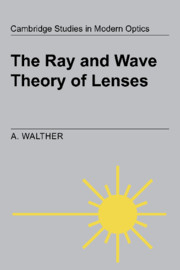Book contents
- Frontmatter
- Contents
- Preface
- Part one Preview
- Part two Geometrical optics
- 2 Fermat's principle
- 3 Path differentials
- 4 The structure of image forming pencils
- 5 Eikonal transformations
- 6 Perfect images
- 7 Aberrations
- 8 Radiometry
- Part three Paraxial optics
- Part four Waves in homogeneous media
- Part five Wave propagation through lenses
- Part six Aberrations
- Part seven Applications
- Appendix 1 Fourier transforms
- Appendix 2 Third order calculations
- Appendix 3 Ray tracing
- Appendix 4 Eikonals and the propagation kernels
- Appendix 5 Paraxial eikonals
- Appendix 6 Hints and problem solutions
- Bibliography
- Index
2 - Fermat's principle
Published online by Cambridge University Press: 22 September 2009
- Frontmatter
- Contents
- Preface
- Part one Preview
- Part two Geometrical optics
- 2 Fermat's principle
- 3 Path differentials
- 4 The structure of image forming pencils
- 5 Eikonal transformations
- 6 Perfect images
- 7 Aberrations
- 8 Radiometry
- Part three Paraxial optics
- Part four Waves in homogeneous media
- Part five Wave propagation through lenses
- Part six Aberrations
- Part seven Applications
- Appendix 1 Fourier transforms
- Appendix 2 Third order calculations
- Appendix 3 Ray tracing
- Appendix 4 Eikonals and the propagation kernels
- Appendix 5 Paraxial eikonals
- Appendix 6 Hints and problem solutions
- Bibliography
- Index
Summary
Introduction
Geometrical optics is based on the concept that light travels along rays. Rays are lines in space that satisfy Fermat's principle, which states that light travels from one point to another along a path for which the travel time is stationary with respect to small variations in the shape of the path. The theory of geometrical optics can be founded on other ideas as well; for instance, Bruns based his classic paper [5] on the law of Malus and Dupin, which states that a fan of rays jointly perpendicular to a surface in the object space emerges from the lens with again all its rays jointly perpendicular to a surface. We could also simply start with Snell's law. All these starting points are logically equivalent; but broad insights into the properties and limitations of lenses can be obtained most easily by starting with Fermat's principle. One conclusion we can draw immediately: in a homogeneous medium light travels along straight lines.
The speed of light depends on the medium traversed. The ratio of the speed in vacuum and the speed in a medium is called the refractive index, usually denoted by the symbol n. In an inhomogeneous medium the speed, and therefore the refractive index, varies from point to point. In an anisotropic medium the speed depends on the direction of propagation, which makes the specification of the refractive index rather more complicated. Except for propagation in vacuum, the speed of light always depends on the wavelength.
- Type
- Chapter
- Information
- The Ray and Wave Theory of Lenses , pp. 13 - 19Publisher: Cambridge University PressPrint publication year: 1995

